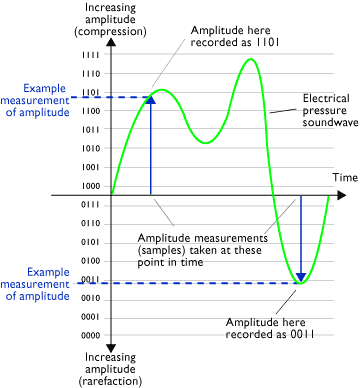Hello everybody. This week we will be learning about the analog to digital conversion, according to lesson for week 2 of Introduction to Music Production at Coursera.org.
So first of all, what is analog and digital?
As we said last week, sound is produced by pressure variations in the air. When a microphone converts the input signal into voltage (through a cable, an amplifier or stereo), the electrical current vary similarly to the variation in the air pressure generated by the sound wave. It is continuous and constant, like pressure variations. That´s why it is called analogue (similar).
On the other hand, digital systems need to convert the input audio signal into digital data that could be processed by numerical calculations. This process results into digital information based on bits (basic unit of information in computing and digital communications). The term bit is a contraction of BInary digIT.
A single bit can have only one of two values, and may therefore be physically implemented with a two-state device. So, having a single bit, the two values can be interpreted as logical values (true/false, yes/no), algebraic signs (+/−), states (on/off), or any other two-valued attribute. The most common representation of these values are 0 and 1. But if we want to represent larger numbers, we have to start a bit string, collecting bits into "words", so a specific number of bits (word length) allows the representation of a specific number of values.
How does it work? How do we convert one into the other? The analog to digital process
 The device responsible for changing an analog signal into a series of numbers is the analog-to-digital converter (or A/D converter). It works by repeatedly measuring the amplitude (volume) of an incoming electrical pressure soundwave (an electrical voltage), and outputting these measurements as a long list of samples, assigning a binary value for each sample´s amplitude. In this way, a mathematical "picture" of the shape of the wave is created. Every audio interface has an Analog-Digital Converter.
The device responsible for changing an analog signal into a series of numbers is the analog-to-digital converter (or A/D converter). It works by repeatedly measuring the amplitude (volume) of an incoming electrical pressure soundwave (an electrical voltage), and outputting these measurements as a long list of samples, assigning a binary value for each sample´s amplitude. In this way, a mathematical "picture" of the shape of the wave is created. Every audio interface has an Analog-Digital Converter.
The converter's sample rate dictates how often it measures the signal to generate a new value, splitting the signal into samples separated by identical time intervals. The amount of samples measured per seconds is called Sample Rate. The more frequently the converter measures the signal, the more accurate the resulting data. To capture the full audio spectrum up to around 20,000 cycles (or 20kHz), a sample rate of 44.1kHz is common. Higher sample rates make for increased treble response and a more "hi-fi" sound. Low sample rates sound duller and darker.
Bit depth affects how many bits the converter uses for each numerical measurement of the signal. More bits equal a more accurate measurement, which explains why 16-bit CD audio sounds so much better than an 8-bit multimedia sound file. A low bit depth is like forcing the converter to measure the sound with a yardstick marked only in inches. A higher bit depth allows the converter much greater accuracy (a yardstick marked in 1/8th-inch increments, for example).
It may help to picture the interaction of sample rate and bit depth as a grid used to measure an audio signal. A higher sample rate corresponds to better accuracy on the horizontal axis; greater bit depth corresponds to vertical resolution.
With this process, the audio signal changes a fundamental characteristic: It stopped being a continuous to become a discrete signal, which is discontinuous, separated by steps, and this important because as we gain something with digital audio, we also loose something else. While digital audio offers high precision, simplified editing and processing, storage facility and audio quality over time, analog sound is known to provide more sound depth and warmth, though is prone to produce higher noise levels, and to deteriorate with time.
Reflections
This topic is quite complex and interesting, it's a really fascinating process that represents the basis of all current digital recording technology. Without this process, the digitalization of the sound signals would not be possible. I hope you find useful this simplified explanation of this important process. Thanks very much for reading again, don't forget to comment.


I didn't understand when you said, at the end, "analog signals tend to deteriorate within time". Well are you saying that the media witch stores analog media tends to deteriorate?
ResponderEliminar